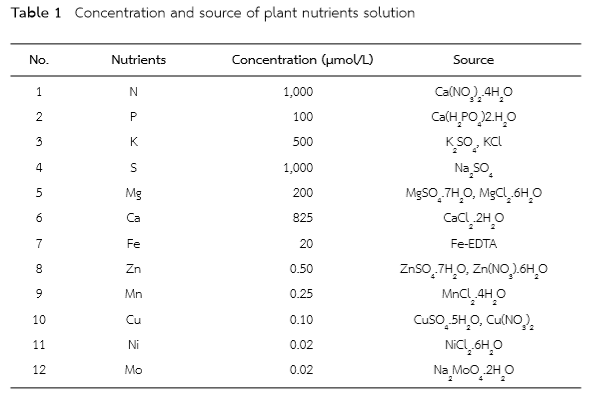ผลของการขาดไนโตรเจน โพแทสเซียม และกำมะถัน ต่อการเจริญเติบโตและการดูดดึงธาตุอาหารในมันสำปะหลัง Effect of nitrogen, potassium and sulfur deficiency on growth and nutrients uptake in cassava (Manihot esculenta L. Crantz)
Main Article Content
Abstract
ไนโตรเจน โพแทสเซียม และกำมะถัน เป็นธาตุอาหารที่จำเป็นสำหรับมันสำปะหลัง จึงทำการศึกษาผลของการขาดธาตุไนโตรเจน โพแทสเซียมและกำมะถันต่อการเจริญเติบโต ผลผลติและการดูดดึงธาตุอาหารของมันสำปะหลังโดยปลูกมันสำปะหลังพันธุ์เกษตรศาสตร์ 50 (KU50) ด้วยเทคนิค Omission trial โดย ใช้ทรายเป็นวัสดุปลูก ให้ธาตุอาหารในรูปของ สารละลาย วางแผนการทดลองแบบสุ่มบล็อก สมบูรณ์ ประกอบด้วย 5 ตำรับการทดลอง 4 ซ้ำ ได้แก่ ไม่มีการให้ธาตุอาหาร (Control) ให้ ธาตุอาหารครบทุกธาตุ(All) ไม่มีการให้ไนโตรเจน (-N) ไม่มีการให้โพแทสเซียม (-K) และไม่มีการ ให้กำมะถัน (-S) ทำการทดลองเป็นเวลา 4 เดือน จากผลการทดลองพบว่าการขาดไนโตรเจน (N) โพแทสเซียม (K) และกำมะถัน (S) ส่งผลให้ ความสูง น้ำหนักสด และน้ำหนักแห้งของแผ่นใบ ลำต้น+ก้านใบ เหง้า และรากมันสำปะหลัง ใน ตำรับการทดลอง –N ,–K, -S และ control ต่ำกว่าตำรับการทดลอง All อย่างมีนัยสำคัญ ทางสถิติ นอกจากนี้ตำรับการทดลอง –N, –S และ –K ส่งผลให้น้ำหนักแห้งหัวมันสำปะหลัง ลดลง 100.00, 28.40 และ 33.35% ตามลำดับ เมื่อเทียบกับตำรับการทดลอง All การขาด ไนโตรเจนในตำรับการทดลอง -N และ control ส่งผลให้ค่า SPAD ต่ำที่สุด และแตกต่างอย่าง มีนัยสำคัญทางสถิติกับตำรับการทดลองอื่นๆ ใน ตำการทดลอง –N ,–K, -S ความเข้มข้นของ N K และ S ในทุกส่วนของพืชต่ำ และในตำรับการ ทดลอง –N พบความเข้มข้นของโพแทสเซียมสูง แต่ความเข้มข้นของกำมะถันต่ำในทุกส่วนของพืช นอกจากนี้ตำรับการทดลอง -N ส่งผลต่อการ ดูดดึงธาตุอาหารทุกธาตุต่ำ ตำรับการทดลอง -K ทำให้ดูดดึงโพแทสเซียม แคลเซียมและกำมะถันต่ำและตำรับการทดลอง -S ทำให้การดูดดึงไนโตรเจน โพแทสเซียม แคลเซียม และกำมะถันต่ำ
Nitrogen, potassium, and sulfur are significant to growth and yield of cassava. The objective of this experiment was to study effects of nitrogen potassium and sulfur deficiency on growth and nutrients uptake of cassava. Kasetsart 50 (KU50) variety was planted with omission trials in sand culture and provided nutrients in the solution form. The experimental design was randomized complete block design (RCBD) with five treatments i.e. distillation water (control), All nutrients (All), minus N (-N), minus K (-K) and minus S (-S) with 4 replications. The cassava was harvested at 4 months after planting. The results showed that deficiency of nitrogen, potassium, and sulfur were affected to height, fresh and dry weight of leave blade, stalk+petio, crown and root which –N, -K and –S treatments was significant decreased as compared to that of treatment All. Moreover, tuber yield was decreased 100.00, 28.40 and 33.35% in treatments
–N, -K and –S respectively as compared with All treatment, respectively. SPAD value of cassava in control and -N treatment was lower than those of other treatments. Total N, K and S in -N, -K and -S treatment was low concentration in all plant parts. In addition, -N treatment enhanced high concentration of total K and low total S concentration in all plant part. Moreover, nitrogen deficiency affected to low nutrient uptake. Total potassium, total calcium, and total sulfur uptake in -K treatment was significant decreased when compared with All treatment while total nitrogen, potassium, calcium and sulfur uptake in -S treatment was low.
